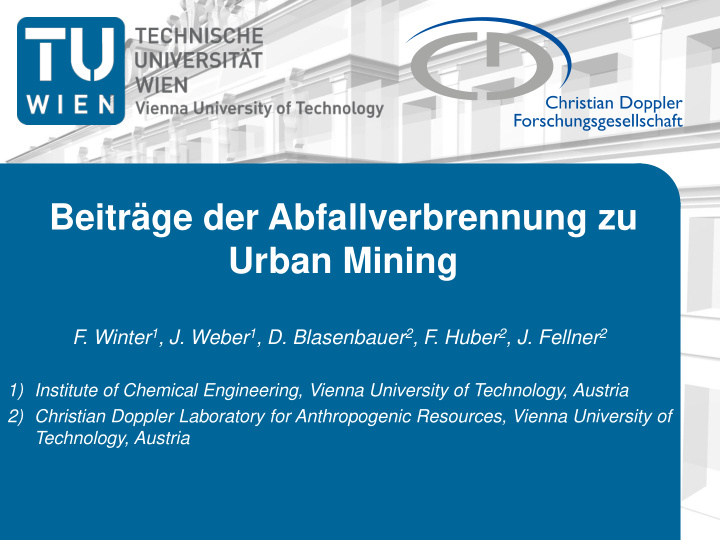



Beiträge der Abfallverbrennung zu Urban Mining F. Winter 1 , J. Weber 1 , D. Blasenbauer 2 , F. Huber 2 , J. Fellner 2 1) Institute of Chemical Engineering, Vienna University of Technology, Austria 2) Christian Doppler Laboratory for Anthropogenic Resources, Vienna University of Technology, Austria
Waste generation Anthropogenic Resources Source: OECD Data 2015 2
Viennese Perspective Anthropogenic Resources Vienna – capital of Austria • 1.7 million inhabitants • 9 million t of waste annually (2009) 0,36 1,89 Sewage sludge with ca. 96% water Non-hazardous waste 6,75 Hazardous waste In million t, data based on Viennese Waste Mangement Report 2012 3
Viennese Perspective Anthropogenic Resources Vienna – non-hazardous waste 10000 4100 1000 587 174 [kt] 100 49 26 10 1 Soil & Municipal solid Paper Bulky waste Used glass Construction waste In kilo t, data based on Viennese Waste Mangement Report 2012 4
Waste to Energy and more … Anthropogenic Resources Fly ash Filter cake Municipial solid waste Incineration Slag / Bottom ash Fe and Non-Fe separation Fe and Non-Fe separation 5
Europe Anthropogenic Resources Number of reference lines 180 160 140 120 100 80 60 40 20 0 grate rotary kiln fluidised bed furnace pyrolysis gasification Source: Review of the BREF for Waste Incineration 2016, Gleis M., Waste Management Vol. 6 6
Austria Anthropogenic Resources Number of reference lines 14 12 10 8 6 4 2 0 grate rotary kiln fluidised bed Source: H. Stoiber, Umweltbundesamt, DepoTech 2016 7
Vienna’s Waste Incineration Cluster Anthropogenic Resources ~10 6 t of waste are incinerated in Vienna each year 4 incineration sites with 13 lines 8
MVA Spittelau overview Anthropogenic Resources • Incineration lines: 2 • Kapazität: 250.000 t/a • Power: thermal: 58 MW electric: 15 MW • Grate furnace • Flue gas cleaning: baghouse filter with activated coke injection, scrubber 1, scrubber 2, SCR-plant 9
RHKW Linz Anthropogenic Resources • Incineration lines: 1 • Capacity: 200.000 t/a waste 50.000 t/a sewage sludge • Power: thermal: ca. 45 MW electric: ca. 15 MW • Fluidized Bed Combustion • Flue gas cleaning: cyclone, baghouse filter with activated coke injection, scrubber 1, scrubber 2, SCR-plant • Special: combined combustion of MSW and sewage sludge, The MSW is treated and homogenized in a waste treatment plant 10
Waste allocation in Vienna Anthropogenic Resources 9% GF1 23% GF2 16% GF3 FB2 FB1 11% 20% RK 21% Approx. 1,025.000. t of waste/a 11
Fly ash allocation in Vienna Anthropogenic Resources 5% 18% GF1 GF2 7% GF3 38% FB2 8% FB1 RK 24% approx. 45.000 t of fly ash/a 12
Slag / bottom ash allocation in Vienna Anthropogenic Resources 9% 0% GF1 6% 28% GF2 GF3 FB2 30% FB1 RK 27% approx. 160.000 t of slag and bottom ash/a 13
Waste incineration residues in Vienna Anthropogenic Resources 100% 90% 80% 70% 60% 50% 40% 30% 20% 10% 0% GF1 GF2 GF3 FB2 FB1 RK Fly Ash Slag Bottom ash Filter Cake Without separated metals approx. 160.000 t of slag and bottom ash/a approx. 45.000 t of fly ash/a approx. 1.500 t of filter cake/a 14
Waste to Energy and more: Example Spittelau Anthropogenic Resources for 2011 Fly ash 3.000 t Filter cake Input (MSW): 230 t 199.500 t Incineration Slag / Bottom ash Fe and Non-Fe 41.500 t separation Fe and Non-Fe separation 3.500 t Source: Umwelterklärung 2014, Wien Energie 15
Mass reduction in Spittelau (Grate Furnace) Anthropogenic Resources Landfill for 1.5 kg filter cake hazardous ~ 0.15 % Waste 20kg fly ash Treatment ~ 2% then 1000kg waste Incineration Landfill for 200kg slag/bottom ash non- ~ 20% hazardous waste 17,5kg scrap ~ 1.75% 16
Waste to Energy and more: Example RHKW Linz Anthropogenic Resources for 2014 Fly ash 20.000 t Filter cake Input (MSW and sludge) 223 t ca. 227.000 t Incineration Bottom ash Fe and Non-Fe 33.600 t separation Fe and Non-Fe separation 305 t Source: Umwelterklärung 2014, Linz AG Strom 17
Mass reduction in RHKW Linz (fluidized bed) Anthropogenic Resources Landfill for 0,98 kg filter cake hazardous ~ 0,1 % Waste 88kg fly ash Treatment ~ 9% then 1000kg waste Incineration Landfill for 148kg slag/bottom ash non- ~ 15% hazardous waste 1,3kg scrap ~ 0,1% 18
Conclusions Anthropogenic Resources • significant reduction in the mass of the waste (up to about one fifth) • significant reduction of the volume of the waste (up to about one tenth) • destruction of organic content • controlled concentration of pollutants in fly ash and filter cake (e.g. Cd, Zn) • separation of metals from residues (Urban Mining) • electricity and district heating generation 19
Acknowledgements Anthropogenic Resources The presented work is part of a large-scale research initiative on anthropogenic resources (Christian Doppler Laboratory for Anthropogenic Resources). The financial support of this research initiative by the Federal Ministry of Economy, Family and Youth and the National Foundation for Research, Technology and Development is gratefully acknowledged. Industry partners co-financing the research center on anthropogenic resources are Altstoff Recycling Austria AG (ARA), Borealis group, voestalpine AG, Wien Energie GmbH, Wiener Kommunal-Umweltschutzprojektgesellschaft GmbH, and Wiener Linien GmbH & Co KG. The authors want to express their particular gratitude to the municipal department 48 of the City of Vienna for not only co-financing this project via its subsidiary WKU, but also for its essential contribution to the experiments in the form of facilities and staff. The International Energy Agency (IEA) – Fluidized Bed Conversion (FBC) Implementing Agreement is kindly thanked for fruitful discussions and the BMVIT for the financial support (FFG Project No. 843139). 20
Anthropogenic Resources Thank you for your attention! 21
Recommend
More recommend